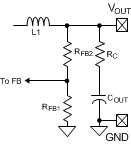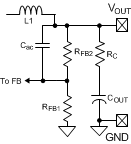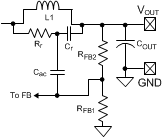ZHCSD64G December 2012 – May 2021 LM25018
PRODUCTION DATA
- 1 特性
- 2 应用
- 3 说明
- 4 Revision History
- 5 Pin Configuration and Functions
- 6 Specifications
-
7 Detailed Description
- 7.1 Overview
- 7.2 Functional Block Diagram
- 7.3
Feature Description
- 7.3.1 Control Overview
- 7.3.2 VCC Regulator
- 7.3.3 Regulation Comparator
- 7.3.4 Overvoltage Comparator
- 7.3.5 On-Time Generator
- 7.3.6 Current Limit
- 7.3.7 N-Channel Buck Switch and Driver
- 7.3.8 Synchronous Rectifier
- 7.3.9 Undervoltage Detector
- 7.3.10 Thermal Protection
- 7.3.11 Ripple Configuration
- 7.3.12 Soft Start
- 7.4 Device Functional Modes
-
8 Application and Implementation
- 8.1 Application Information
- 8.2
Typical Applications
- 8.2.1 Application Circuit: 12.5-V to 48-V Input and 10-V, 325-mA Output Buck Converter
- 8.2.2 Application Curves
- 8.2.3
Typical Isolated DC-DC Converter Using LM25018
- 8.2.3.1 Design Requirements
- 8.2.3.2
Detailed Design Procedure
- 8.2.3.2.1 Transformer Turns Ratio
- 8.2.3.2.2 Total IOUT
- 8.2.3.2.3 RFB1, RFB2
- 8.2.3.2.4 Frequency Selection
- 8.2.3.2.5 Transformer Selection
- 8.2.3.2.6 Primary Output Capacitor
- 8.2.3.2.7 Secondary Output Capacitor
- 8.2.3.2.8 Type III Feedback Ripple Circuit
- 8.2.3.2.9 Secondary Diode
- 8.2.3.2.10 VCC and Bootstrap Capacitor
- 8.2.3.2.11 Input Capacitor
- 8.2.3.2.12 UVLO Resistors
- 8.2.3.2.13 VCC Diode
- 8.2.3.3 Application Curves
- 9 Power Supply Recommendations
- 10Layout
- 11Device and Documentation Support
- 12Mechanical, Packaging, and Orderable Information
7.3.11 Ripple Configuration
The LM25018 uses constant on-time (COT) control scheme, in which the on-time is terminated by an on-timer, and the off-time is terminated by the feedback voltage (VFB) falling below the reference voltage (VREF). Therefore, for stable operation, the feedback voltage must decrease monotonically, in phase with the inductor current during the off-time. Furthermore, this change in feedback voltage (VFB) during off-time must be large enough to suppress any noise component present at the feedback node.
Table 7-1 shows three different methods for generating appropriate voltage ripple at the feedback node. Type 1 and Type 2 ripple circuits couple the ripple at the output of the converter to the feedback node (FB). The output voltage ripple has two components:
- Capacitive ripple caused by the inductor current ripple charging/discharging the output capacitor.
- Resistive ripple caused by the inductor current ripple flowing through the ESR of the output capacitor.
The capacitive ripple is not in phase with the inductor current. As a result, the capacitive ripple does not decrease monotonically during the off-time. The resistive ripple is in phase with the inductor current and decreases monotonically during the off-time. The resistive ripple must exceed the capacitive ripple at the output node (VOUT) for stable operation. If this condition is not satisfied unstable switching behavior is observed in COT converters, with multiple on-time bursts in close succession followed by a long off-time.
Type 3 ripple method uses Rr and Cr and the switch node (SW) voltage to generate a triangular ramp. This triangular ramp is ac-coupled using Cac to the feedback node (FB). Since this circuit does not use the output voltage ripple, it is ideally suited for applications where low output voltage ripple is required. See AN-1481 Controlling Output Ripple and Achieving ESR Independence in Constant On-Time (COT) Regulator Designs Application Report for more details for each ripple generation method.
| TYPE 1 LOWEST COST CONFIGURATION | TYPE 2 REDUCED RIPPLE CONFIGURATION | TYPE 3 MINIMUM RIPPLE CONFIGURATION |
|---|---|---|
 |  |  |
Equation 5.  | Equation 6.  | Equation 7.  |